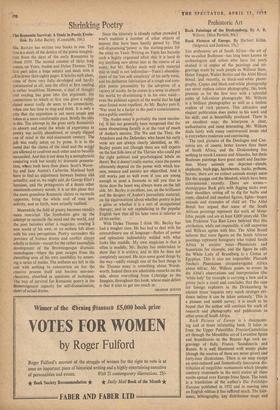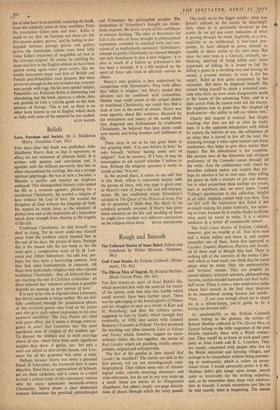Rock Pictures of Europe. By Herbert Kiihn. (Sidgwick and Jackson,
35s.)
THE prehistoric art of South Africa—the art of the so-called Bushmen—has long been known to
archaeologists and artists who have for years studied it in copies of the paintings and en- gravings made, by such people as William Stow,
Helen Tongue, Walter Battiss and the Abbe Henri Breuil, and recently, in black-and-white photo- graphy. Copies and black-and-white photographs can never replace colour photography; this book presents us for the first time with a /splendid series of full-colour photographs. Mr. Willcox is a brilliant photographer as well as a tireless student of rock pictures. This attractive and elegant publication does justice to his work and his skill; and is beautifully produced. There is an excellent map; the letterpress is clear, authoritative. and most interesting. Mr. Willcox deals fairly with many controversial issues and is everywhere moderate and convincing.
The rock pictures of the Dordogne and Can- tabria are, of course, better known than those of South Africa, and the Drakensberg has nothing to touch Lascaux and Altamira, but these Bushmen paintings have great merit and fascina- tion. Many animals are depicted—elands, elephants, bush-pigs, hartebeeste, bucks, pythons, horses; there are no extinct animals except some like the quagga and the bloubok, which have been exterminated recently. There are scenes- steatopygous Bush girls with digging sticks over their shoulders setting off to dig for bulbs and roots, cloaked and masked figures, fights—bogey animals and examples of child art. The Abbe Breuil has argued that some of the South African paintings represent the work of Meso- lithic people and are at least 8,000 years old. The late Professor Van Riet Lowe believed that this attribution, while not impossible, is'still unproven and Willcox agrees with him. The Abbe Breuil believes that some figures on the South African paintings represent foreigners who visited South Africa in ancient, times—Phoenicians and Sumerians for ekample, and the figure he calls the White Lady of Brandberg is a Cretan or Egyptian. This is also not impossible; Pharaoh Necho's Phoenicians circumnavigated Africa about 600 BC. Mr. Willcox points to errors ih the Abbe's observations and interpretation (the 'white lady' for example is carrying a bow and is prima facie a man) and concludes that the case for foreign explorers in the Drakensberg in ancient times 'requires very much stronger evi- dence before it can be taken seriously.' This is a pioneer and model survey; it is much to be hoped that the author will continue his work of research and photography and publication in other areas of South Africa.
Rock Pictures of Europe is a disappoint- ing and at times infuriating book. It takes us from the Upper Palaeolithic Franco-Cantabrian art through the Mesolithic art of Levantine Spain and Scandinavia to the Bronze Age rock en- gravings' of Italy, France, Scandinavia • and Russia. It is well illustrated with ninety plates (though the sources of these are never given) and forty-four illustrations. There is no map except an over-reduced and fantastically inaccurate dis- tribution of megalithic monuments which (despite contrary statements in the text) makes all these tombs spread over Europe from Spain. The book is a translation of the author's Die Felsbilder Europas published in 1952 and in moving into an English edition it has suffered much. The foot- notes, bibliography, key distribution maps and list of sites have been omitted, rendering the book, from the scholarly point of view, worthless. Even the translation falters now and then : Ktihn is made to say that 'on German soil there are but five known gallery graves,' and by failing to dis- tinguish between passage graves and gallery graves the translation vitiates even what little value Killm's treatment of megalithic art had in the German original. Of course, by omitting the maps and lists in the English edition we have been spared seeing again some gross errors, like the totally inaccurate maps and lists of British and French post-Palaeolithic rock pictures. But there are errors enough in the text to make any reviewer turn purple with rage. On his own special subject, Palaeolithic art, Professor Kuhn is interesting and stimulating, but the book, taken as a whole, does not provide us with a reliable guide to the rock pictures of Europe. This is sad, as there is no other book known to me in English which deals so fully with some of the material he has studied.
GLYN DANIEL



































 Previous page
Previous page